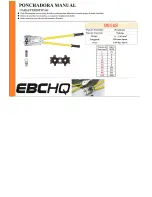
g) Unscrew the sleeve back up the bronze feed screw.
(i.e. Looking along the length of the tool from cap end
towards the drill end, the sleeve turns counter-clock-
wise to extend the tool). Turn the sleeve all the way
until it stops. Again measure the distance from a
point such as the wrench flats on the feed screw to
the end of the sleeve. In Figure 7 it is 15
″
. Subtract
the distance from the previous step (h) from this dis-
tance. The result is 14
″
full stroke. Note that the
stroke distance may be affected by various valve
adapter / cutter combinations. Record the stroke in the
worksheet provided on page 13.
Figure 7 – Measuring full stoke distance
h) Attach the selected service saddle to the main in
accordance with the manufacturer’s specifications, or
weld the selected threadolet or weldolet to the main
in accordance with all applicable welding standards.
i) Apply pipe sealant to the threads on the “corporation
stop” or valve and tightly thread it into the saddle or
Thread-O-Let™ to assure a leak proof assembly.
Ensure that the valve is in the CLOSED position.
j) Measure the distance from the surface of the pipe to
the outlet end of the valve as shown in Figure 8 & 9.
This is the minimum amount of stroke required before
the cutter makes contact with the pipe to be drilled
into. (In the illustrated example this is 4
1
/
2
″
.) Record
this dimension in the worksheet provided. If this dis-
tance is within 1 inch of the stroke distance from
step (g) then the machine may not have enough
travel to safely complete the tap and this operation
must be aborted and reconfigured for a different
valve and/or saddle.
k) Measure the distance from the far surface of the
pipe to the outlet end of the valve as shown in Figure
10. This is the maximum amount of stroke required
before breaking through the far side of the pipe to be
drilled into. (In the illustrated example this is 10
1
/
2
″
.)
Record this dimension in the worksheet provided. If
this distance is less than the stroke distance from step
(g) then the machine has enough travel to penetrate
the far side of the pipe. This is true in the illustrated
case. Therefore, this operation must be carefully ex-
ecuted to avoid problems.
Figure 8 – Measuring valve standoff distance
Figure 9 – Measuring valve standoff distance
RT3422 Tapping Tool
Ridge Tool Company
8
































